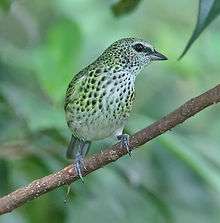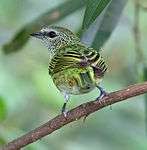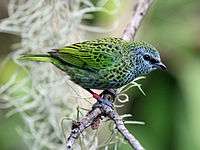Spotted tanager
The spotted tanager (Ixothraupis punctata) is a species of bird in the family Thraupidae. It is found in Bolivia, Brazil, Ecuador, French Guiana, Guyana, Peru, Suriname, and Venezuela. Its natural habitats are subtropical or tropical moist lowland forests and subtropical or tropical moist montane forests.
| Spotted tanager | |
|---|---|
 | |
| Scientific classification | |
| Kingdom: | Animalia |
| Phylum: | Chordata |
| Class: | Aves |
| Order: | Passeriformes |
| Family: | Thraupidae |
| Genus: | Ixothraupis |
| Species: | I. punctata |
| Binomial name | |
| Ixothraupis punctata (Linnaeus, 1766) | |
| Synonyms | |
|
Tanagra punctata Linnaeus, 1766 | |
Taxonomy
In 1760 the French zoologist Mathurin Jacques Brisson included a description of the spotted tanager in his Ornithologie based on a specimen collected in the West Indies. He used the French name Le tangara verd piqueté des Indes and the Latin name Tangara viridis indica punctulata.[2] Although Brisson coined Latin names, these do not conform to the binomial system and are not recognised by the International Commission on Zoological Nomenclature.[3] When in 1766 the Swedish naturalist Carl Linnaeus updated his Systema Naturae for the twelfth edition he added 240 species that had been previously described by Brisson in his Ornithologie.[3] One of these was the spotted tanager. Linnaeus included a terse description, coined the binomial name Tanagra punctata and cited Brisson's work.[4] The specific name punctata is Latin for "spotted".[5] There are five subspecies.[6]
Gallery
References
- BirdLife International (2012). "Tangara punctata". IUCN Red List of Threatened Species. 2012. Retrieved 26 November 2013.CS1 maint: ref=harv (link)
- Brisson, Mathurin Jacques (1760). Ornithologie, ou, Méthode contenant la division des oiseaux en ordres, sections, genres, especes & leurs variétés (in French and Latin). Volume 3. Paris: Jean-Baptiste Bauche. pp. 19–20, Plate 4 fig 2. The two stars (**) at the start of the paragraph indicates that Brisson based his description on the examination of a specimen.
- Allen, J.A. (1910). "Collation of Brisson's genera of birds with those of Linnaeus". Bulletin of the American Museum of Natural History. 28: 317–335.
- Linnaeus, Carl (1766). Systema naturae : per regna tria natura, secundum classes, ordines, genera, species, cum characteribus, differentiis, synonymis, locis (in Latin). Volume 1, Part 1 (12th ed.). Holmiae (Stockholm): Laurentii Salvii. p. 316.
- Jobling, J.A. (2018). del Hoyo, J.; Elliott, A.; Sargatal, J.; Christie, D.A.; de Juana, E. (eds.). "Key to Scientific Names in Ornithology". Handbook of the Birds of the World Alive. Lynx Edicions. Retrieved 2 April 2018.
- Gill, Frank; Donsker, David, eds. (2018). "Tanagers and allies". World Bird List Version 8.1. International Ornithologists' Union. Retrieved 2 April 2018.


